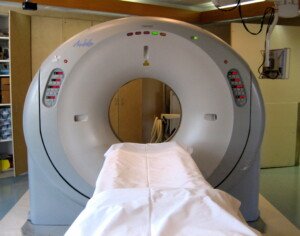
When is dizziness serious enough to warrant a head CT scan, being that this procedure emits radiation to the brain?
Many people go to the ER for feeling dizzy.
The sudden onset of what the patient can only describe as “dizziness” can be quite frightening, especially when they fall or feel nauseous as a result.
They may need to quickly sit down or even fall on the way to a chair.
Kaiser Foundation Hospital researchers reported that less than 7.1 percent of patients in the ER complaining of dizziness benefited from a head CT.
About only 6.4 percent of patients with faintness benefited.
The CT scan is fast and easy, but apparently much overused, says this study.
But ultimately, the ordering of a head CT should be based on each patient’s unique situation, including their medical history, rather than a percentage from a study.
Doctors definitely want to make sure they cover all their bases when dealing with dizziness in patients — which could have both benign and serious causes.
So it’s easy to understand when in general, CT scans are over-ordered.
After all, what if a scan isn’t ordered, and it turns out the patient had a brain tumor, which then caused a seizure while they were driving the next day — resulting in a fatal car accident?
On the other hand, it just wouldn’t be logistically possible for every single patient who reports dizziness to have a head CT scan.
When to Get a CT Scan of Your Brain

Liz West, Boxborough, MA, CC Wikimedia Commons
“Dizziness is a common complaint in general practice, and the severity of the symptoms we see is likely to be milder than those seen by hospital doctors,” says Dr. David Beatty, MD, a retired general practitioner with 30+ years of experience and an instructor of general medicine for 20+ years.
“It’s important to work out whether the patient is lightheaded and feeling they might faint, or whether it is vertigo — more of a spinning sensation.”
Feeling faint is not the same as dizziness, and the patient needs to be clear about that when describing symptoms to a doctor or physician’s assistant.
If the patient has only one symtpom — dizziness or lightheadedness — the CT scan is unlikely to be necessary.
A doctor or P.A. will check for neurological signs that increase the suspicion of a more serious cause of the dizziness.
Worrisome neurological signs include: increasing headache pain, deteriorating level of consciousness or increasing drowsiness, speech problems, vision problems and weakness.
Another very concerning sign is vomiting, though that can be caused by benign vertigo.
A careful medical history should also be taken.
Often, with only one symptom (feeling dizzy) and a non-eventful medical history, there won’t be a need for a CT scan, but the patient will be advised to follow up with their primary care physician the next day.
How about when to go to the ER for dizziness?
“If symptoms are getting progressively worse this would be a bad sign,” says Dr. Beatty.
He also points out that benign paroxysmal positional vertigo can be so severe that the sufferer can’t even walk. An ER visit is in order.
BPPV is easy to diagnose, and, while the patient is lying down, the doctor will move his head to resettle the natural crystal-like structures floating around in the inner ear.
“If there are other neurological symptoms like loss of power, speech difficulty, loss of coordination, bad headache or double vision, consider the ER.”

 Dr. Beatty has worked in primary medicine, surgery, accident and emergency, OBGYN, pediatrics and chronic disease management. He is the Doctor of Medicine for
Dr. Beatty has worked in primary medicine, surgery, accident and emergency, OBGYN, pediatrics and chronic disease management. He is the Doctor of Medicine for 







































